Bequest of the Norseman—The Potential for Agricultural Intensification and Expansion in Southern Greenland under Climate Change
Abstract
:1. Introduction
2. Material and Methods
2.1. Study Area
2.2. Sampling Setup
2.3. Soil Sampling and Analysis
2.4. Soil Quality Index (SQI)
3. Results and Discussion
3.1. Suitability of the Sampled Fields for Agricultural Use
3.2. Impact of the Agricultural Use on Soil and Landscape Ecology
3.3. Identifying the Most Suitable Areas
3.4. Improvement of Soil Quality by Directed Measures
4. Conclusions
Acknowledgments
Author Contributions
Conflicts of Interest
References
- Hassol, S.J. Impacts of a Warming Arctic: Arctic Climate Impact Assessment; Cambridge University Press: Cambridge, UK; New York, NY, USA, 2004; ISBN 978-0-521-61778-9. [Google Scholar]
- Christensen, J.; Olesen, M.; Boberg, F.; Stendel, M.; Koldtoft, I. Fremtidige Klimaforandringer i Grønland: Kujalleq Kommune; Videnskabelig Rapport 15-04 (1/6); Danmarks Meteorologiske Institut: København, Denmark, 2016. [Google Scholar]
- Greenland Agricultural Consulting Service. Available online: http://www.nunalerineq.gl/english/landbrug/index-landbrug.htm (accessed on 2 March 2016).
- Bichet, V.; Gauthier, E.; Massa, C.; Perren, B.; Richard, H.; Petit, C.; Mathieu, O. The history and impacts of farming activities in south Greenland: An insight from lake deposits. Polar Rec. 2013, 49, 210–220. [Google Scholar] [CrossRef]
- Dugmore, A.J.; Keller, C.; McGovern, T.H. Norse Greenland Settlement: Reflections on Climate Change, Trade, and the Contrasting Fates of Human Settlements in the North Atlantic Islands. Arct. Anthropol. 2007, 44, 12–36. [Google Scholar] [CrossRef]
- Edwards, K.J.; Schofield, J.E.; Kirby, J.R.; Cook, G.T. Problematic but promising ponds? Palaeoenvironmental evidence from the Norse Eastern Settlement of Greenland. J. Quat. Sci. 2011, 26, 854–865. [Google Scholar] [CrossRef]
- Fredskild, B. Erosion and Vegetational Changes in South Greenland Caused by Agriculture. Geogr. Tidsskr.-Dan. J. Geogr. 1992, 92, 14–21. [Google Scholar] [CrossRef]
- Sørensen, A.K. Denmark-Greenland in the Twentieth Century (Vol. 341); Museum Tusculanum Press: Copenhagen, Denmark, 2007; ISBN 978-87-635-3070-5. [Google Scholar]
- Austrheim, G.; Asheim, L.J.; Bjarnason, G.; Feilberg, J.; Fosaa, A.M.; Holand, Ø.; Høegh, K.; Jonsdottir, I.S.; Magnusson, B.; Mortensen, L.E.; et al. Sheep grazing in the North-Atlantic region—A long term perspective on management, resource economy and ecology. Rep. Zool. Ser. 2008, 3, 1–82. [Google Scholar]
- Jacobsen, N.K. Studies on soils and potential for soil erosion in the sheep farming area of south Greenland. Arct. Alp. Res. 1987, 19, 498–507. [Google Scholar] [CrossRef]
- Rambøll Management Consulting. Where Can Development Come From? Potentials and Pitfalls in Greenland’s Economic Sectors towards 2025; Rambøll Management Consulting: Copenhagen, Denmark, 2014; p. 65. Available online: http://download.ramboll-environ.com/ramboll/Greenpeace-report.pdf (accessed on 29 February 2016).
- Hayashi, N. Incorporating Climate Change Remedies into Community Development in Greenland. In Cultural Dynamics of Climate Change and the Environment in Northern America; Sommer, B., Ed.; Climate and Culture; Brill: Leiden, The Netherlands; Boston, MA, USA, 2015; Volume 3, pp. 283–303. [Google Scholar]
- Ministry of Fisheries, Hunting & Agriculture, Greenland. Grønlands Statistik. 2014 Statistisk Årbog; Fiskeri, Fangst og Landbrug: Nuuk, Greenland, 2014; p. 36.
- Taufetter, G. Arctic Harvest: Global Warming a Boon for Greenland’s Farmers. Spieg. Online. 2006. Available online: http://www.spiegel.de/international/spiegel/arctic-harvest-global-warming-a-boon-for-greenland-s-farmers-a-434356.html (accessed on 2 March 2016).
- Pleitgen. Farming to the Fore as Greenland Ice Thaws. 2012. Available online: http://edition.cnn.com/2012/12/04/world/greenland-secrets/ (accessed on 11 July 2016).
- Ministry of Fisheries, Hunting & Agriculture, Greenland. Økonomisk. Analyse af det Grønlandske Landbrug; Ministry of Fisheries, Hunting & Agriculture: Nuuk, Greenland, 2008. Available online: http://naalakkersuisut.gl/~/media/Nanoq/Files/Publications/Fangst%20og%20fiskeri/DK/Udgivelser_EL_%C3%98konomisk%20analyse%20af%20det%20gr%C3%B8nlandske%20landbrug_april%202008_DK.pdf (accessed on 2 March 2016).
- Høeg, K.; Isaksen, E.; Frederiksen, A.; Hansen, H.; Poulsen, K.; Iversen, A.; Devisme, A. Årsberetning 2006/2007 fra Konsulenttjenesten for Landbrug. 2007. Available online: http://www.nunalerineq.gl/dansk/raad/aarsberet/Aarsberetning%202006%202007%20DK.pdf (accessed on 16 May 2016).
- Landbrugskommisionen. Landbrugskommissionens Betænkning; Landbrugskommisionen: Nuuk, Greenland, 2014; p. 110. Available online: http://naalakkersuisut.gl/~/media/Nanoq/Files/Attached%20Files/Fiskeri_Fangst_Landbrug/DK/2016/Final_Rapport%20landbrug%202014_Chair_DK_pdf.pdf. (accessed on 13 November 2017).
- Høegh, K.; Lund Stidsen, P.; Frederiksen, A.; Hansen, H.; Motzfeldt, N.; Gard, J.; Petersen, M. Årsberetning 2007/2008 fra Konsulenttjenesten for Landbrug. 2008. Available online: http://www.nunalerineq.gl/dansk/raad/aarsberet/Aarsberetning%202007%202008%20DK.pdf (accessed on 16 May 2016).
- Høegh, K.; Isaksen, G.; Frederiksen, A.; Hansen, H.; Poulsen, K.; Iversen, A.; Devisme, A. Årsberetning fra Konsulenttjenesten for Landbrug. 2006. Available online: www.nunalerineq.gl/dansk/raad/aarsberet/Aarsberetning%202005%202006%20DK.pdf (accessed on 16 May 2016).
- Westergaard-Nielsen, A.; Bjørnsson, A.B.; Jepsen, M.R.; Stendel, M.; Hansen, B.U.; Elberling, B. Greenlandic sheep farming controlled by vegetation response today and at the end of the 21st Century. Sci. Total Environ. 2015, 512–513, 672–681. [Google Scholar] [CrossRef]
- Zornoza, R.; Acosta, J.A.; Bastida, F.; Domínguez, S.G.; Toledo, D.M.; Faz, A. Identification of sensitive indicators to assess the interrelationship between soil quality, management practices and human health. Soil 2015, 1, 173–185. [Google Scholar] [CrossRef]
- Doran, J.W.; Parkin, T.B. Defining and assessing soil quality. Defin. Soil Qual. Sustain. Environ. 1994, 35, 3–21. [Google Scholar]
- Schiefer, J.; Lair, G.J.; Blum, W.E. H. Indicators for the definition of land quality as a basis for the sustainable intensification of agricultural production. Int. Soil Water Conserv. Res. 2015, 3, 42–49. [Google Scholar] [CrossRef]
- Doran, J.W. Soil health and global sustainability: Translating science into practice. Agric. Ecosyst. Environ. 2002, 88, 119–127. [Google Scholar] [CrossRef]
- Hansen, B.U. Satellite Monitoring of the Biomass Production in Southern Greenland. Geogr. Tidsskr.-Dan. J. Geogr. 1988, 88, 94–101. [Google Scholar] [CrossRef]
- Brooks, K. A tale of two intrusions—Where familiar rock names no longer suffice. Geol. Today 2012, 28, 13–19. [Google Scholar] [CrossRef]
- Hanna, E.; Cappelen, J. Recent climate of southern Greenland. Weather 2002, 57, 320–328. [Google Scholar] [CrossRef]
- Feilberg, J. A Phytogeographical Study of South Greenland, Vascular Plants; Commission for Scientific Research in Greenland: Copenhagen, Denmark, 1984. [Google Scholar]
- Madsen, C.K. Pastoral Settlement, Farming, and Hierarchy in Norse Vatnahverfi, South Greenland. Ph.D. Thesis, University of Copenhagen, Copenhagen, Denmark, 2014. [Google Scholar]
- Daniёls, F.J. A geobotanical impression of South. Greenland with some remarks on its “Boreal Zone.”. In In Proceedings of the Fifth International Workshop: Conservation of Arctic Flora and Fauna (CAFF) Flora Group. Circumboreal Vegetation Mapping (CBVM) Workshop, Helsinki, Finland, 3–6 November 2008; CAFF Technical Report No. 21. Talbot, S., Charron, T., Barron, T., Eds.; CAFF International Secretariat: Helsinki, Finland, 2010; pp. 85–94. [Google Scholar]
- Arneborg, J. Saga Trails-Brattahlid, Gardar, Hvalsey Fjord’s Church and Herjolfnesnes: Four Chieftain’s Farmsteads in the Norse Settlement of Greenland; The National Museum of Denmark: Copenhagen, Denmark, 2007. [Google Scholar]
- Perren, B.B.; Massa, C.; Bichet, V.; Gauthier, É.; Mathieu, O.; Petit, C.; Richard, H. A paleoecological perspective on 1450 years of human impacts from a lake in southern Greenland. Holocene 2012, 22, 1025–1034. [Google Scholar] [CrossRef]
- Kommune Kujalleq Kommuneplanen-Igaliku, Redegørelse og Delområder. Available online: http://kujalleq.odeum.com/download/pdf/da/14_igaliku_redegoerelse_og_delomraader.pdf (accessed on 20 July 2016).
- FAO. Guidelines for Soil Description, 4th ed.; Food and Agriculture Organization of the United Nations: Rome, Italy, 2006; ISBN 978-92-5-105521-2. [Google Scholar]
- Arshad, M.A.; Martin, S. Identifying critical limits for soil quality indicators in agro-ecosystems. Agric. Ecosyst. Environ. 2002, 88, 153–160. [Google Scholar] [CrossRef]
- Agroscope FAL Reckenholz. Schweiz. Referenzmethoden der Eidg. Landwirtschaftlichen Forschungsanstalten; Eidgenössische Forschungsanstalten FAL, RAC, FAW: Zürich, Switzerland, 1996. [Google Scholar]
- Sponagel, H. Bodenkundliche Kartieranleitung: Mit 41 Abbildungen, 103 Tabellen und 31 Listen; Bundesanstalt für Geow. und Rohstoffe: Hannover, Germany, 2005; ISBN 978-3-510-95920-4. [Google Scholar]
- Scheffer, F.; Schachtschabel, P.; Blume, H.-P. Soil Science, 1st ed.; Springer: Berlin, Germany, 2016; ISBN 978-3-642-30941-0. [Google Scholar]
- Amacher, M.C.; O’Neil, K.P.; Perry, C.H. Soil Vital Signs: A New Soil Quality Index (SQI) for Assessing Forest Soil Health; Department of Agriculture, Forest Service, Rocky Mountain Research Station: Fort Collins, CO, USA, 2007; pp. 1–12. [Google Scholar]
- Flisch, R.; Sinaj, S.; Charles, R.; Richner, W. Grundlagen für die Düngung im Acker- und Futterbau-Kapitel 7-10. Agrar. Schweiz 2009, 16, 32–49. [Google Scholar]
- Stevenson, F.J.; Cole, M.A. Cycles of Soil: Carbon, Nitrogen, Phosphorus, Sulfur, Micronutrients, 2nd ed.; Wiley: New York, NY, USA, 1999; ISBN 978-0-471-32071-5. [Google Scholar]
- Marzaioli, R.; D’Ascoli, R.; De Pascale, R.A.; Rutigliano, F.A. Soil quality in a Mediterranean area of Southern Italy as related to different land use types. Appl. Soil Ecol. 2010, 44, 205–212. [Google Scholar] [CrossRef]
- Armenise, E.; Redmile-Gordon, M.A.; Stellacci, A.M.; Ciccarese, A.; Rubino, P. Developing a soil quality index to compare soil fitness for agricultural use under different managements in the Mediterranean environment. Soil Tillage Res. 2013, 130, 91–98. [Google Scholar] [CrossRef]
- Kaiser, H.F. The Application of Electronic Computers to Factor Analysis. Educ. Psychol. Meas. 1960, 20, 141–151. [Google Scholar] [CrossRef]
- Wander, M.M.; Bollero, G.A. Soil Quality Assessment of Tillage Impacts in Illinois. Soil Sci. Soc. Am. J. 1999, 63, 961–971. [Google Scholar] [CrossRef]
- Qi, Y.; Darilek, J.L.; Huang, B.; Zhao, Y.; Sun, W.; Gu, Z. Evaluating soil quality indices in an agricultural region of Jiangsu Province, China. Geoderma 2009, 149, 325–334. [Google Scholar] [CrossRef]
- Western Plant Health Association. Western Fertilizer Handbook; Waveland Press: Long Grove, IL, USA, 2010; ISBN 978-1-57766-679-0. [Google Scholar]
- Flisch, R.; Sinaj, S.; Charles, R.; Richner, W. Grundlagen für die Düngung im Acker- und Futterbau-Kapitel 3-6. Agrar. Schweiz. 2009, 16, 6–31. [Google Scholar]
- Prasad, R.; Power, J.F. Soil Fertility Management for Sustainable Agriculture; CRC/Lewis Publishers: Boca Raton, FL, USA, 1997; ISBN 978-1-56670-254-6. [Google Scholar]
- Liebig, M.A.; Varvel, G.; Doran, J. A Simple Performance-Based Index for Assessing Multiple Agroecosystem Functions. Agron. J. 2001, 93, 313–318. [Google Scholar] [CrossRef]
- Andrews, S.S.; Karlen, D.L.; Cambardella, C.A. The soil management assessment framework. Soil Sci. Soc. Am. J. 2004, 68, 1945–1962. [Google Scholar] [CrossRef]
- Landwirtschaftskammer Nordrhein-Westfalen. Grunddüngung. mit Phosphat., Kali, Magnesium; Landwirtschaftskammer Nordrhein-Westfalen: Münster, Germany, 2015; pp. 1–4. Available online: https://www.landwirtschaftskammer.de/landwirtschaft/ackerbau/pdf/phosphat-kalium-magnesium-pdf.pdf (accessed on 10 July 2016).
- Edwards, K.J.; Schofield, J.E. Investigation of proposed Norse irrigation channels and dams at Garðar/Igaliku, Greenland. Water Hist. 2013, 5, 71–92. [Google Scholar] [CrossRef]
- Christensen, K.N. Grønlands jord under kultur. Tidskr. Grønl. 1953, 11, 407–413. [Google Scholar]
- Adderley, W.P.; Simpson, I.A. Soils and palaeo-climate based evidence for irrigation requirements in Norse Greenland. J. Archaeol. Sci. 2006, 33, 1666–1679. [Google Scholar] [CrossRef]
- De Neergaard, E.; Stougaard, P.; Høegh, K.; Munk, L. Climatic changes and agriculture in Greenland: Plant diseases in potatoes and grass fields. In Proceedings of the IOP Conference Series: Earth and Environmental Science, Copenhagen, Denmark, 10–12 March 2009. [Google Scholar]
- Dollerup-Scheibel, M. Borgmester Jørgen Wæver Johansen Efterlyser Hjælp til Trængte Landmænd. SermitsiaqAG Online. 2015. Available online: http://knr.gl/da/nyheder/landbruget-ramt-af-t%C3%B8rke (accessed on 7 July 2016).
- Hannestad, A. Tørke Hærger Grønlands Landbrug. Politiken. 2015. Available online: http://politiken.dk/oekonomi/gloekonomi/ECE2888287/toerke-haerger-groenlands-landbrug/ (accessed on 7 July 2016).
- Myers, R. The Basics of Chemistry (Basics of the Hard Sciences); Greenwood Press: Westport, CT, USA, 2003; ISBN 978-0-313-31664-7. [Google Scholar]
- Niedersächsisches Landesamt für Ökologie (NLÖ). Anwenderhandbuch für Die Zusatzberatung Wasserschutz: Grundwasserschutzorientierte Bewirtschaftungsmaßnahmen in der Landwirtschaft und Methoden zu Ihrer Erfolgskontrolle; Hildesheim. 2001. Available online: http://www.nlwkn.niedersachsen.de/download/95902/NLWKN_2015_Anwenderhandbuch_fuer_die_Zusatzberatung_Wasserschutz_Grundwasserschutzorientierte_Bewirtschaftungsmassnahmen_in_der_Landwirtschaft_und_Methoden_zu_ihrer_Erfolgskontrolle_Band_21_.pdf (accessed on 15 July 2016).
- Chambre d’Agriculture. Das Info.-Blatt des Wasserschutzberatungsdienstes der Landwirtschaftskammer. Chambre d’Agriculture Wasserschutzberodung: Strassen, Luxenburg, 2015; pp. 1–4. Available online: http://www.lwk.lu/download/838/lwk-waasserschutzberodung-info-2015-4.pdf (accessed on 7 July 2016).
- Belle, S.; Rius, D.; Bichet, V.; Massa, C.; Mavon, C.; Millet, L. Combining limnology and paleolimnology to assess the influence of climate change on two lakes in Southern Greenland. Polar Biol. 2017, 1–13. [Google Scholar] [CrossRef]
- Krøjer, A.K. Landbrug i Sydgrønland-Svære produktionsvilkår i det arktiske miljø. Tidskr. Grønl. 2000, 8, 283–289. [Google Scholar]
- Galler, J. Kalkdüngung Basis für Fruchtbare Böden; Landwirtschaftskammer Salzburg, Betriebsentwicklung und Umwelt: Salzburg, Austria, 2008; pp. 1–27. [Google Scholar]
- Retamero, F.; Schjellerup, I.; Davies, A. (Eds.) Early Agricultural Remnants and Technical Heritage (EARTH): 8000 Years of Resilience and Innovation; Oxbow Books: Oxford, UK; Philadelphia, PA, USA, 2016; ISBN 978-1-84217-359-6. [Google Scholar]
- Massa, C.; Bichet, V.; Gauthier, É.; Perren, B.B.; Mathieu, O.; Petit, C.; Monna, F.; Giraudeau, J.; Losno, R.; Richard, H. A 2500 year record of natural and anthropogenic soil erosion in South Greenland. Quat. Sci. Rev. 2012, 32, 119–130. [Google Scholar] [CrossRef]
- Arneborg, J. Greenland irrigation systems on a West Nordic background: An overview of the evidence of irrigation systems in Norse Greenland c. 980-1450 AD. Pamatky Archeol. Suppl. 2005, 17, 137–145. [Google Scholar]
- Arneborg, J.; Lynnerup, N.; Heinemeier, J.; Møhl, J.; Rud, N.; Sveinbjörnsdóttir, Á.E. Norse Greenland dietary economy ca. AD 980-ca. AD 1450: Introduction. J. North Atl. 39. [CrossRef]
- Kielsen, K.; Frederiksen, S. Muligheder for Klimatilpasning i Landbrugserhvervet—Status og Handlemuligheder; Aarhus Universitet and Government of Greenland: Aarhus, Denmark, 2017; pp. 1–50. [Google Scholar]
- Schofield, J.E.; Edwards, K.J.; Mighall, T.M.; Martínez Cortizas, A.; Rodríguez-Racedo, J.; Cook, G. An integrated geochemical and palynological study of human impacts, soil erosion and storminess from southern Greenland since c. AD 1000. Palaeogeogr. Palaeoclimatol. Palaeoecol. 2010, 295, 19–30. [Google Scholar] [CrossRef]
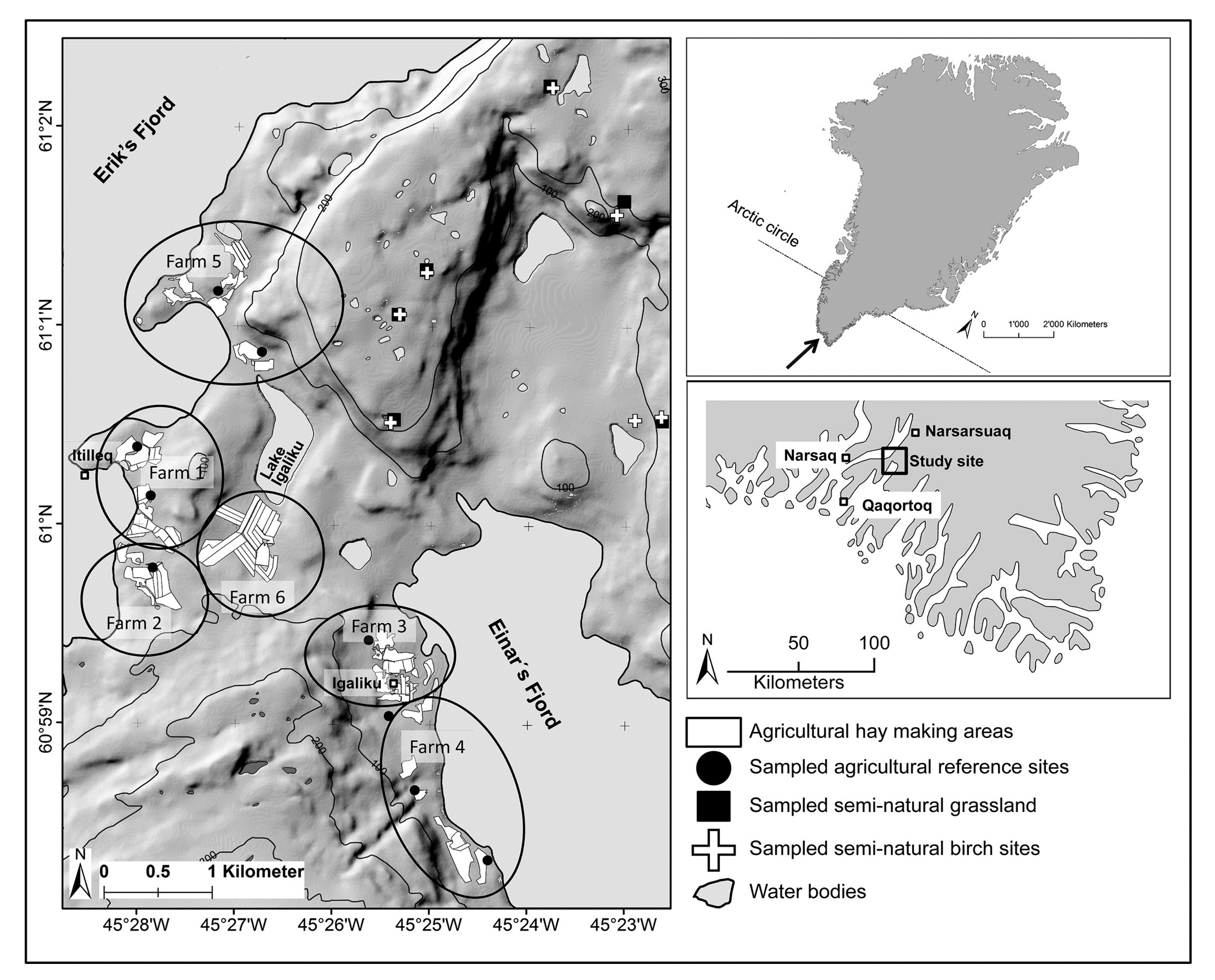
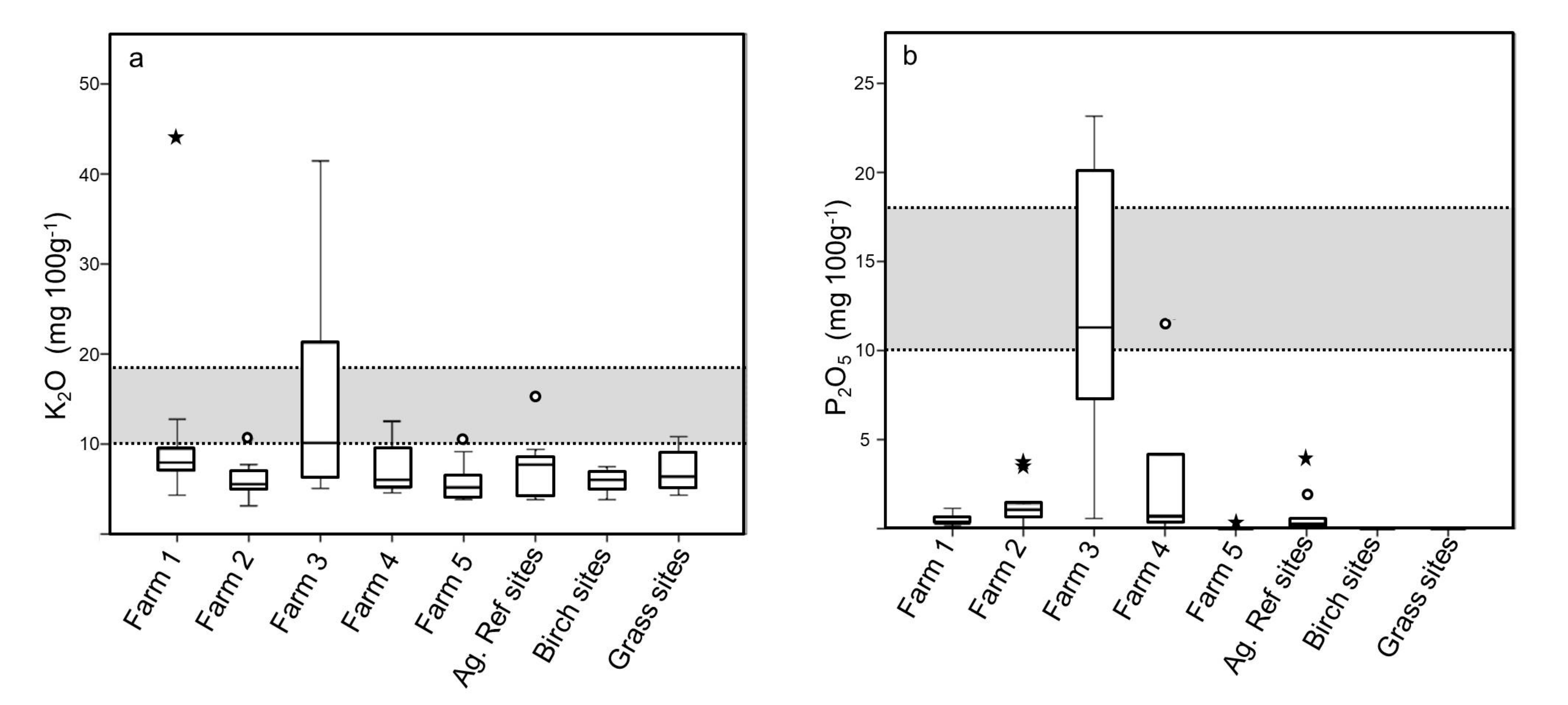
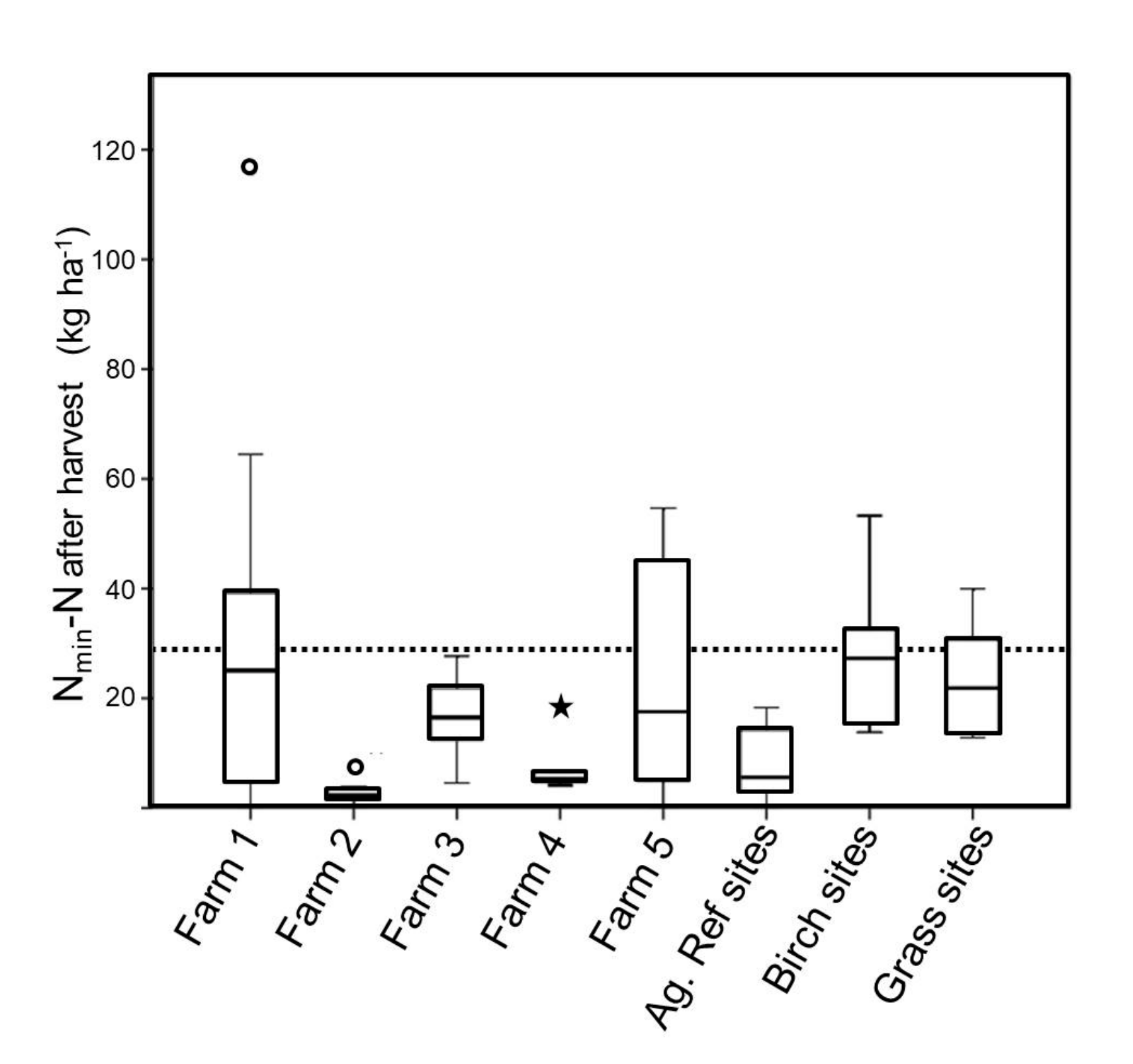
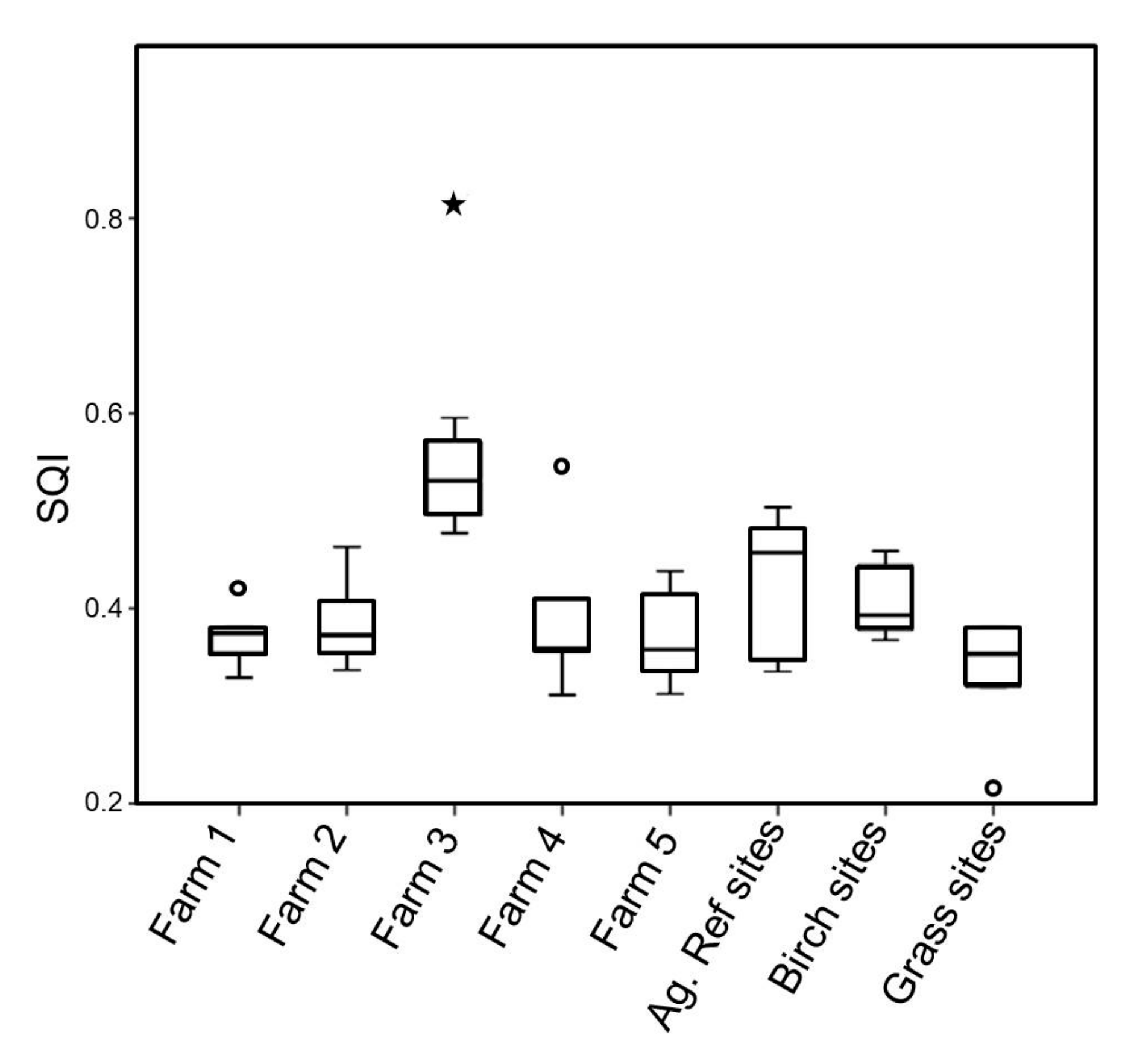
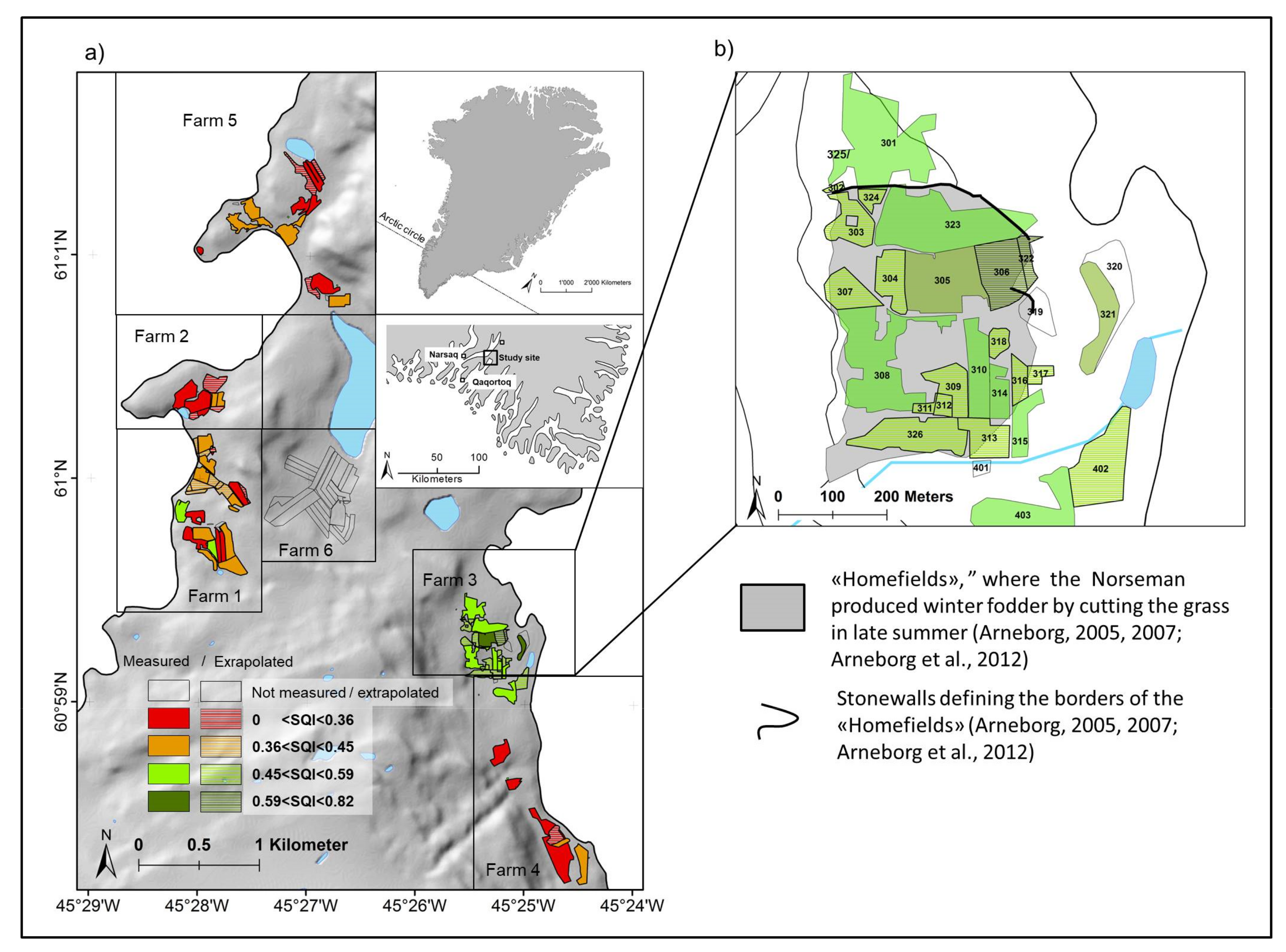
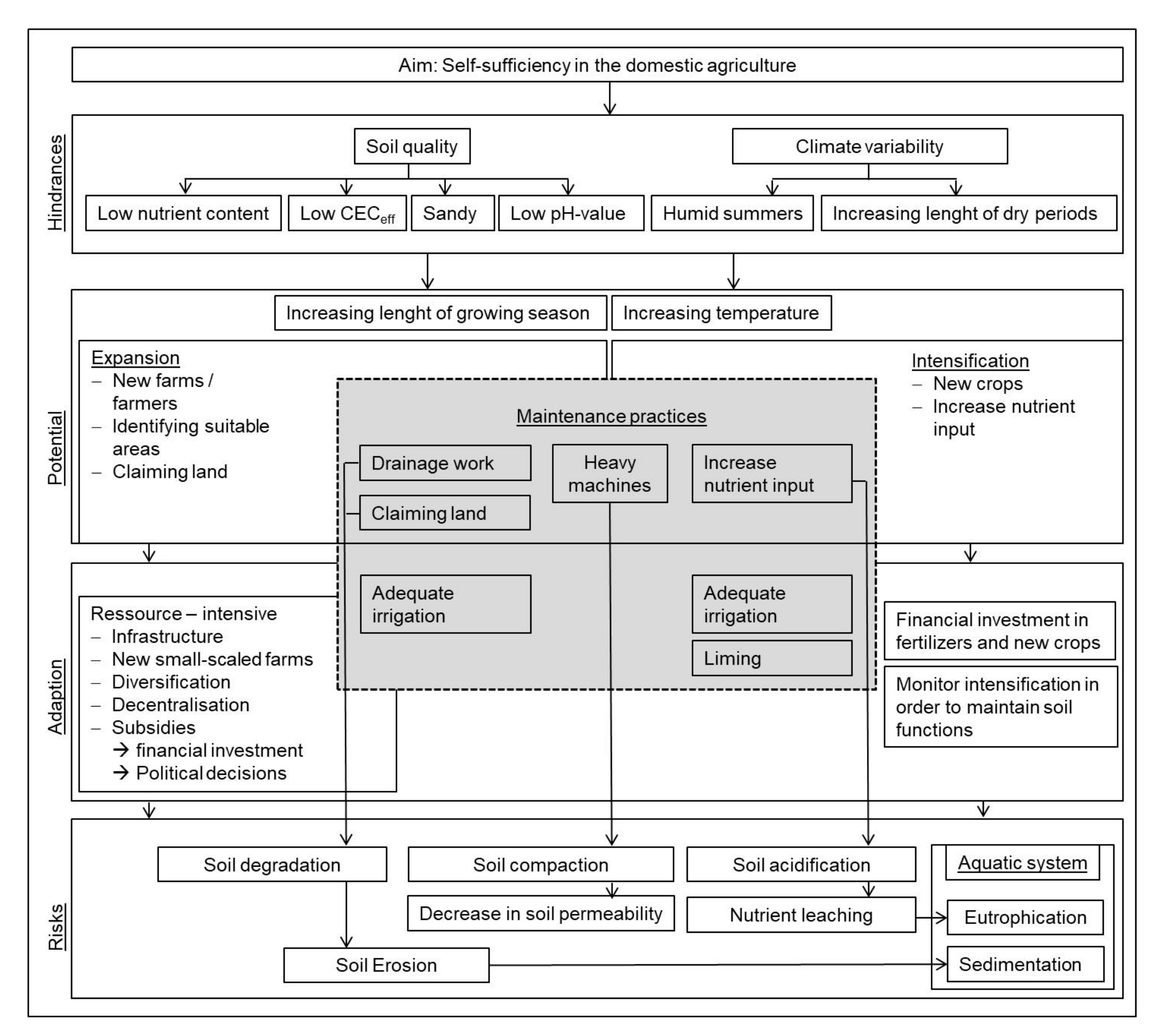
| Site | Sampling Site Characteristics | Size of Sampling Area | |
|---|---|---|---|
| Farm 1 n = 10 | Mean elevation (m a.s.l.) | 21 ± 14 Stdv.; Range 38 | Parcel size |
| Mean slope (°) | 6 ± 3 Stdv.; Range 9 | ||
| Aspect | N: 0, NE: 0, E: 0; SE: 0, S: 0, SW: 2, W: 6, NW: 2 | ||
| Slope position | CR: 0, UP: 0, MS: 6, LS: 4, TS: 0, BO: 0 | ||
| Slope form | SS: 8, SV: 0, SC: 1, VS: 1, VV: 0, VC: 0, CS: 0,CV: 0, CC: 0 | ||
| Soil texture | Sandy loam: 10, Loamy sand: 0, Sand: 0 | ||
| Farm 2 n = 11 | Mean elevation (m a.s.l.) | 53 ± 15 Stdv.; Range 40 | Parcel size |
| Mean slope (°) | 7 ± 3 Stdv.; Range 9 | ||
| Aspect | N: 2, NE: 0, E: 0; SE: 0, S: 0, SW: 0, W: 7, NW: 2 | ||
| Slope position | CR: 0, UP: 0, MS: 3, LS: 5, TS: 3, BO: 0 | ||
| Slope form | SS: 6, SV: 0, SC: 2, VS: 0, VV: 0, VC: 0, CS: 3, CV: 0, CC: 0 | ||
| Soil texture | Sandy loam: 11, Loamy sand: 0, Sand: 0 | ||
| Farm 3 n = 8 | Mean elevation (m a.s.l.) | 22 ± 9 Stdv.; Range 24 | Parcel size |
| Mean slope (°) | 3 ± 2 Stdv.; Range 4 | ||
| Aspect | N: 0, NE: 0, E: 7; SE: 0, S: 1, SW: 0, W: 0, NW: 0 | ||
| Slope position | CR: 0, UP: 0, MS: 4, LS: 4, TS: 0, BO: 0 | ||
| Slope form | SS: 5, SV: 0, SC: 2, VS: 0, VV: 1, VC: 0, CS: 0, CV: 0, CC: 0 | ||
| Soil texture | Sandy loam: 8, Loamy sand: 0, Sand: 0 | ||
| Farm 4 n = 5 | Mean elevation (m a.s.l.) | 34 ± 12 Stdv.; Range 24 | Parcel size |
| Mean slope (°) | 5 ± 2 Stdv.; Range 4 | ||
| Aspect | N: 1, NE: 0, E: 4; SE: 0, S: 0, SW: 0, W: 0, NW: 0 | ||
| Slope position | CR: 0, UP: 0, MS: 5, LS: 0, TS: 0, BO: 0 | ||
| Slope form | SS: 2, SV: 0, SC: 0, VS: 1, VV: 0, VC: 1, CS: 0, CV: 0, CC: 1 | ||
| Soil texture | Sandy loam: 4, Loamy sand: 1, Sand: 0 | ||
| Farm 5 n = 10 | Mean elevation (m a.s.l.) | 28 ± 14 Stdv.; Range 45 | Parcel size |
| Mean slope (°) | 6 ± 3 Stdv.; Range 10 | ||
| Aspect | N: 1, NE: 0, E: 0; SE: 0, S: 0, SW: 5, W: 1, NW: 3 | ||
| Slope position | CR: 0, UP: 0, MS: 5, LS: 2, TS: 0, BO: 3 | ||
| Slope form | SS: 3, SV: 0, SC: 2, VS: 1, VV: 1, VC: 0, CS: 2, CV: 0, CC: 1 | ||
| Soil texture | Sandy loam: 10, Loamy sand: 0, Sand: 0 | ||
| Agricultural reference sites n = 9 | Mean elevation (m a.s.l.) | 33 ± 12 Stdv.; Range 34 | 10 m × 10 m |
| Mean slope (°) | 7 ± 3 Stdv.; Range 9 | ||
| Aspect | N: 0, NE: 1, E: 3; SE: 0, S: 3, SW: 0, W: 2, NW: 0 | ||
| Slope position | CR: 0, UP: 0, MS: 9, LS: 0, TS: 0, BO: 0 | ||
| Slope form | SS: 5, SV: 1, SC: 2, VS: 1, VV: 0, VC: 0, CS: 0, CV: 0, CC: 0 | ||
| Soil texture | Sandy loam: 7, Loamy sand: 2, Sand: 0 | ||
| Semi-natural birch sites n = 7 | Mean elevation (m a.s.l.) | 199 ± 48 Stdv.; Range 180 | 10 m × 10 m |
| Mean slope (°) | 12 ± 5 Stdv.; Range 16 | ||
| Aspect | N: 0, NE: 0, E: 0; SE: 3, S: 1, SW: 2, W: 1, NW: 0 | ||
| Slope position | CR: 0, UP: 0, MS: 4, LS: 2, TS: 1, BO: 0 | ||
| Slope form | SS: 5, SV: 0, SC: 1, VS: 0, VV: 0, VC: 0, CS: 1, CV: 0, CC: 0 | ||
| Soil texture | Sandy loam: 3, Loamy sand: 4, Sand: 0 | ||
| Semi-natural grassland sites n = 6 | Mean elevation (m a.s.l.) | 221 ± 48 Stdv.; Range 136 | 10 m × 10 m |
| Mean slope (°) | 14 ± 6 Stdv.; Range 13 | ||
| Aspect | N: 0, NE: 0, E: 0; SE: 2, S: 3, SW: 0, W: 1, NW: 0 | ||
| Slope position | CR: 0, UP: 0, MS: 5, LS: 1, TS: 0, BO: 0 | ||
| Slope form | SS: 42, SV: 0, SC: 1, VS: 1, VV: 0, VC: 0, CS: 0,CV: 0, CC: 0 | ||
| Soil texture | Sandy loam: 2, Loamy sand: 2, Sand: 1, Missing: 1 | ||
| Parameter | Significance As Index for Soil Fertility | Analytical Method for Data Determination |
|---|---|---|
| Corg (%) | Index for soil fertility and soil structure. Increases the CEC and the water-holding capacity [36], thus prevents nutrient leaching. | Sieved (<2 mm), ball-milled, total carbon content was determined by the dry combustion technique Leco CN 628 Elemental Determinator, (Ctot was set as Corg as there was no evidence for inorganic carbon) |
| Ntot (%) | Initial source for N mineralization—>Nmin-N (NO3−-N + NH4+-N) | Sieved (<2 mm), ball-milled, nitrogen content was determined by the dry combustion technique by Leco CN 628 Elemental Determinator |
| Macronutrients K, P, Mg, Ca (kg ha−1) | Index for the capacity to support plant growth, environmental quality indicator [36]. | CO2 extraction 1:2.5 soil solution FAL CO2-EX [37], ionchromatography, IC 761 |
| Nmin (NO3-N + NH4+-N) (kg ha−1) | Index plant available soil inorganic nitrogen, leaching potential, mineralization [36]. | Sieved (<2 mm), cooled until soil extraction; extraction with 0.01M Calciumchlorid (1:4); FAL NM-Ex [37], soil nitrate and ammonium determination with QUANTOFIX® rapid test (Machery & Nagel) |
| pH (CaCl2) (-) | Index for soil acidity/alcalinity. Reduced availability of nutrients in acidic soils [36]. Soil acidity influences soil microbes, reduces bacterial activity and thus decomposition [38]. | 1:2.5 0.01 M CaCl2 suspension |
| Cation exchange capacity (CEC) (meq 100 g−1) | Index for soil capacity to supply exchangeable nutrient cations Mgex, Kex, Caex to the soil solution for plant uptake [39]. | For soils with pH (H2O) ≤ 5.9; FAL KUK1-Ex with HCl + H2SO4; KUK1-H; for soils with pH (H2O) > 5.9; KUK2-EX with Bariumchlorid KUK2-H [37]; Measured on CIROS VISION − ICP-OES Spectrometer, CECpot = (Ca2+) + (Mg2+) + (K+) + (Na+) + (H+), CECeff = (Ca2+) + (Mg2+) + (K+) + (Na+) |
| Exchangable sodium (Naex) percentage (ESP) (%) | Addresses potential hazards posed by sodium soils, as for example a decrease in permeability, soil dispersion, poor water infiltration, and possible sodium toxicity to plants [40]. | ESP = [(Na+)/CECpot] × 100 |
| Base saturation (BS) (%) | Indicates whether a soil should be limed or not [41]. | BS= [CECeff/CECpot] × 100 |
| C/N (-) | Indicates mineralization/immobilization of soil nitrogen [42]. | Sieved to 2 mm, ball-milled, the organic carbon content was determined by the dry combustion technique by Leco CN 628 Elemental Determinator; Ratio C/N |
| Bulk density (BD) < 2 mm (g cm−3) | Index for plant rooting, porosity and soil organisms [43]. | Undisturbed soil cores 100 cm3, air dried, sieved to 2 mm;BD = weight dried fine earth/cylinder volume Volume > 2 mm was measured by water replacement of the material > 2 mm, volume < 2 mm was calculated by total volume of the cylinder minus the volume > 2 mm |
| CF (Vol%) | Index for water and nutrient retention potential [40]. | CF = Vol > 2mm/(Vol > 2 mm + Vol < 2 mm) |
| Texture (%) | Index for retention and transport of water and chemicals [36]. | Treatment with H2O2 (15%) to exclude organic material, Mastersizer 2000 (Malvern, Germany) |
| PC 1 | PC 2 | PC 3 | PC 4 | Functional Group | |
|---|---|---|---|---|---|
| Eigenvalue | 7.549 | 2.543 | 1.423 | 1.166 | |
| Percent | 47.18 | 15.894 | 8.893 | 7.285 | |
| Cumulative percent | 47.18 | 63.073 | 71.966 | 79.251 | |
| ESP (%) | 0.933 | 0.166 | 0.009 | 0.138 | The less the better [48] |
| Naex (meq 100 g−1) | 0.852 | 0.344 | 0.093 | 0.157 | |
| C:N ratio (-) | −0.763 | −0.224 | −0.245 | 0.039 | |
| BS (%) | 0.665 | 0.229 | 0.651 | 0.059 | |
| Mgex (meq 100 g−1) | 0.609 | 0.483 | 0.243 | −0.115 | The more the better [43] |
| Corg (%) | 0.343 | 0.799 | 0.179 | 0.317 | The more the better [43] |
| Ntot (%) | 0.477 | 0.755 | 0.219 | 0.246 | |
| P (mg 100 g−1) | 0.343 | 0.739 | −0.032 | −0.133 | Optimal value [49] |
| BD > 2mm (g cm−3) | −0.088 | −0.711 | −0.133 | 0.37 | The less the better [43] |
| Kex (meq 100 g−1) | 0.45 | 0.561 | 0.33 | −0.051 | The more the better [43] |
| Caex (meq 100 g−1) | 0.194 | 0.429 | 0.837 | 0.097 | The more the better [43] |
| pH (CaCl2) | 0.036 | −0.149 | 0.82 | −0.414 | Optimal value [50] |
| CECeff (meq 100 g−1) | 0.533 | 0.528 | 0.644 | 0.062 | |
| Sand (%) | 0.064 | −0.298 | 0.074 | −0.897 | The less the better [38] |
| Clay (%) | 0.237 | −0.074 | 0.015 | 0.844 | |
| CF (Vol-%) | 0.005 | 0.277 | 0.078 | −0.53 | The less the better [38] |
| Site | pH(CaCl2) * (-) | P ** (kg ha−1) | K ** (kg ha−1) | Ca ** (kg ha−1) | Mg ** (kg ha−1) | CECeff ** (meq 100 g−1) | ESP ** (%) | BS ** (%) | Nmin-N ** (kg ha−1) | Corg Stock ** (tha−1) | Ntot Stock ** (tha−1) | C:N Ratio * (-) |
|---|---|---|---|---|---|---|---|---|---|---|---|---|
| Farm 1 | 4.4 ± 0.2 abc | 2.1 ± 2.1 bc | 107.0 ± 29.7 | 128.7 ± 49.9 bc | 24.4 ± 7.7 bc | 2.6 ± 1.1 ad | 0.8 ± 0.3 ab | 16 ± 7 ad | 25.1 ± 34.6 | 116 ± 23 b | 6.8 ± 1.1 ab | 16.3 ± 1.4 ad |
| Ag. Ref 1 | 4.7 ± 0.0 bc | 0.0 f | 58.5 ± 13.1 b | 50.7 ± 61.1 b | 32.4 ± 24.5 | 2.4 ± 1.4 | 1.2 ± 0.5 | 18 ± 9 | 0.0 be | 92 ± 41 | 5.5 ± 2.8 | 16.9 ± 1.4 bg |
| Farm 2 | 4.3 ± 0.3 abcd | 4.7 ± 2.8 bc | 48.5 ± 22.8 abcd | 75.0 ± 64.1 bc | 22.8 ± 10.4 bc | 2.8 ± 2.3 | 0.8 ± 0.4 abd | 18 ± 8 | 2.4 ± 1.7 bcd | 105 ± 20 ab | 6.7 ± 1.7 ab | 15.6 ± 2.0 ad |
| Ag. Ref 2 | 4.4 | 0.0 | 84.0 | 57.7 | 28.9 | 2.4 | 1.1 | 14 | 3.0 | 140 | 8.2 | 17.1 g |
| Farm 3 | 4.7 ± 0.5 | 88.1 ± 54.7 abcd | 156.2 ± 224.0 | 113.0 ± 224.0 c | 40.8 ± 153.1 d | 12.4 ± 4.1 abcd | 6.2 ± 4.6 bcd | 38 ± 11 bcd | 16.5 ± 9.5 ad | 183 ± 87 bc | 15.4 ± 6.8 bcd | 12.5 ± 0.9 bcd |
| Ag. Ref 3 | 5.1 | 13.1 b | 96.2 | 38.2 | 12.2 | 10.1 | 10.3 b | 36 | 7.7 | 133 | 10.7 | 12.5 c |
| Farm 4 | 4.8 ± 0.3 d | 5.9 ± 27.3 bc | 91.2 ± 50.4 | 19.8 ± 32.1 bcd | 16.6 ± 36.0 | 6.5 ± 6.1 bcd | 11.5 ± 2.3 abcd | 40 ± 17 bcd | 5.4 ± 1.8 bc | 93 ± 48 | 7.5 ± 4.4 b | 11.6 ± 0.6 abcd |
| Ag. Ref 4 | 5.1 ± 0.2 e | 3.9 ± 9.5 | 123.8 ± 56.2 | 24.0 ± 100.4 b | 32.8 ± 59.6 | 8.7 ± 9.0 b | 9.3 ± 7.4 b | 39 ± 20 b | 14.2 ± 13.5 | 167 ± 162 b | 16.2 ± 14.5 be | 11.0 ± 0.6 bceg |
| Farm 5 | 4.8 ± 0.2 bc | 0 ± 0 | 80.8 ± 28.1 | 163.7 ± 152.1 | 31.3 ± 12.5 bc | 3.5 ± 0.9 | 1.0 ± 0.1 b | 22 ± 14 | 17.6 ± 10.3 | 112 ± 37 b | 6.6 ± 2.5 b | 15.6 ± 1.2 d |
| Ag. Ref 5 | 5.1 ± 0.3 | 1.3 ± 2.6 | 95.4 ± 72.1 | 577.6 ± 369.8 e | 84.8 ± 64.1 | 10.6 ± 1.2b f | 0.5 ± 1 | 37.5 ± 17 f | 12.0 ± 12.8 | 129 ± 37 b | 9.7 ± 2.1 b | 13.3 bcf |
| Farms 1–5 | 4.6 ± 0.4 abc | 3.6 ± 11.1 bc | 86.8 ± 54.8 | 103.9 ± 112.7 bc | 25.9 ± 17.5 bc | 3.7 ± 5.0 | 1.0 ± 1.3 b | 22 ± 17 | 6.0 ± 19.1 b | 112 ± 35 bc | 7.0 ± 2.1 bc | 14.7 ± 2.2 b |
| Ag. Ref. 1–5 | 4.9 ± 0.3 e | 2.0 ± 3.9 c | 84.0 ± 58.8 | 57.7 ± 98.3 b | 32.8 ± 32.6 | 8.2 ± 6.9 | 1.4 ± 8.3 b | 34 ± 17 b | 5.6 ± 11.2 bc | 133 ± 35 b | 9.9 ± 2.6 b | 13.7 ± 2.7 bc |
| Birch | 5.2 ± 0.4 e | 0.0 ± 0.0 e | 88.9 ± 29.5 | 273.7 ± 295.0 e | 66.6 ± 33.0 e | 3.4 ± 2.5 | 0 ± 0 ae | 14 ± 13 a | 27.3 ± 19.5 ae | 74 ± 19 ae | 4.6 ± 1.8 ae | 16.4 ± 1.3 ae |
| Grass | 5.1 ± 0.4 e | 0.0 ± 0.0 ae | 103.6 ± 33.1 | 326.5 ± 177.1 e | 63.8 ± 17.0 e | 2.9 ± 1.8 | 0 ± 1.9 e | 17 ± 6 | 21.8 ± 16.9 a | 67 ± 69 | 4.2 ± 3.4 | 16.2 ± 0.9 a |
| Site | BD < 2 mm *(gcm−3) | CF **(Vol% ) | Clay **(%) | Silt **(%) | Sand **(%) |
|---|---|---|---|---|---|
| Farm 1 | 1.06 ± 0.11 bd | 5.5 ± 5.3 | 3.2 ± 0.8 b | 38.8 ± 3.8 c | 58.2 ± 4.0 c |
| Ag. Ref 1 | 1.16 ± 0.08 b | 2.5 ± 1.0 | 2.7 ± 0.7 | 36.8 ± 13.2 | 60.5 ± 13.9 |
| Farm 2 | 0.98 ± 0.13 b | 5.0 ± 2.7 | 2.3 ± 0.7 b | 36.4 ± 3.3 c | 60.3 ± 3.9 c |
| Ag. Ref 2 | 1.13 b | 4.3 | 2.8 | 41.0 | 56.2 |
| Farm 3 | 0.68 ± 0.17 acd | 8.0 ± 4.5 d | 2.7 ± 0.5 b | 36.7 ± 7.3 c | 60.7 ± 8.5 |
| Ag. Ref 3 | 0.87 | 4.8 | 2.7 | 39.9 | 57.4 |
| Farm 4 | 0.93 ± 0.11 | 3.9 ± 1.8 | 2.1 ± 2.6 | 33.0 ± 2.6 d | 64.8 ± 3.8 |
| Ag. Ref 4 | 0.97 ± 0.11 b | 7.0 ± 6.6 | 3.2 ± 1.6 | 45.4 ± 22.7 | 51.4 ± 24.3 |
| Farm 5 | 1.10 ± 0.19 bd | 4.7 ± 5.0 | 3.6 ± 0.7 bd | 38.5 ± 3.6 bc | 57.6 ± 3.5 bc |
| Ag. Ref 5 | 0.96 ± 0.10 | 6.5 ± 10.3 | 3.2 ± 0.1 | 40.6 ± 12.0 | 56.2 ± 12.0 |
| Farms 1–5 | 0.96 ± 0.21 b | 5.2 ± 4.8 | 3.0 ± 1.0 b | 38.2 ± 4.7 bc | 59.1 ± 5.8 bc |
| Ag. Ref. 1–5 | 1.02 ± 0.13 b | 4.3 ± 5.0 | 3.0 ± 0.5 b | 41.0 ± 10.7 c | 51.4 ± 10.8 bc |
| Birch | 0.76 ± 0.13 ace | 3.7 ± 8.0 | 0.9 ± 1.7 ae | 28.9 ± 17.2 e | 59.9 ± 19.8 ae |
| Grass | 1.06 ± 0.16 b | 10.8 ± 8.7 | 0.7 ± 2.7 d | 22.2 ± 16.3 ae | 63.3 ± 18.9 ae |
© 2017 by the authors. Licensee MDPI, Basel, Switzerland. This article is an open access article distributed under the terms and conditions of the Creative Commons Attribution (CC BY) license (http://creativecommons.org/licenses/by/4.0/).
Share and Cite
Caviezel, C.; Hunziker, M.; Kuhn, N.J. Bequest of the Norseman—The Potential for Agricultural Intensification and Expansion in Southern Greenland under Climate Change. Land 2017, 6, 87. https://doi.org/10.3390/land6040087
Caviezel C, Hunziker M, Kuhn NJ. Bequest of the Norseman—The Potential for Agricultural Intensification and Expansion in Southern Greenland under Climate Change. Land. 2017; 6(4):87. https://doi.org/10.3390/land6040087
Chicago/Turabian StyleCaviezel, Chatrina, Matthias Hunziker, and Nikolaus J. Kuhn. 2017. "Bequest of the Norseman—The Potential for Agricultural Intensification and Expansion in Southern Greenland under Climate Change" Land 6, no. 4: 87. https://doi.org/10.3390/land6040087




